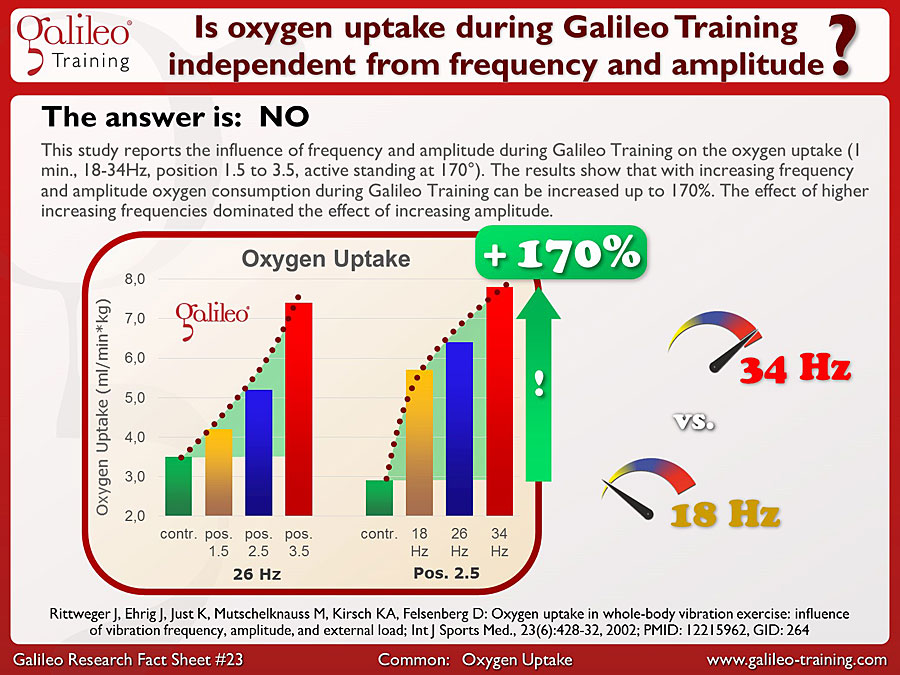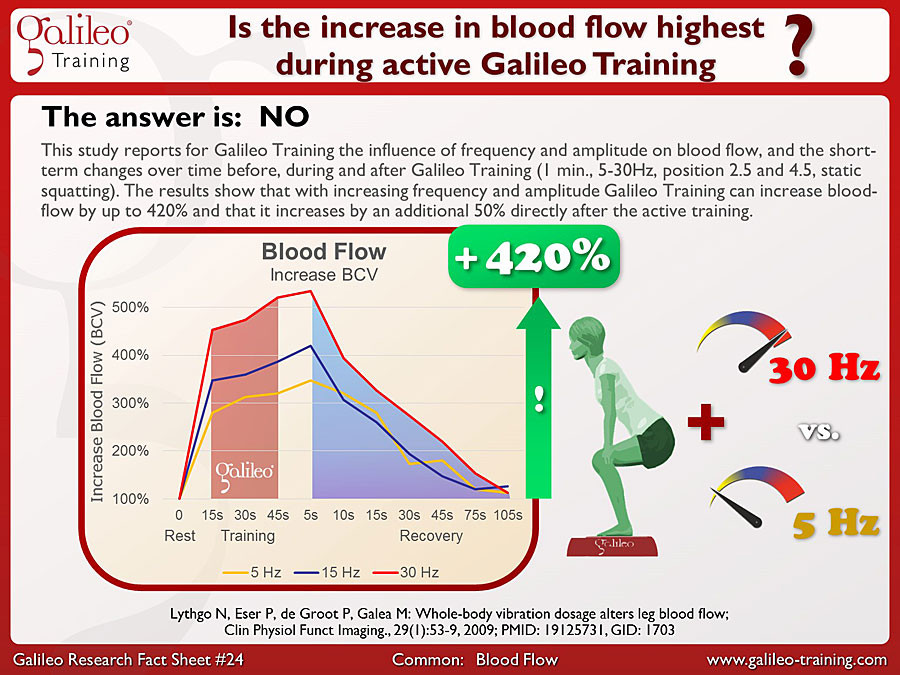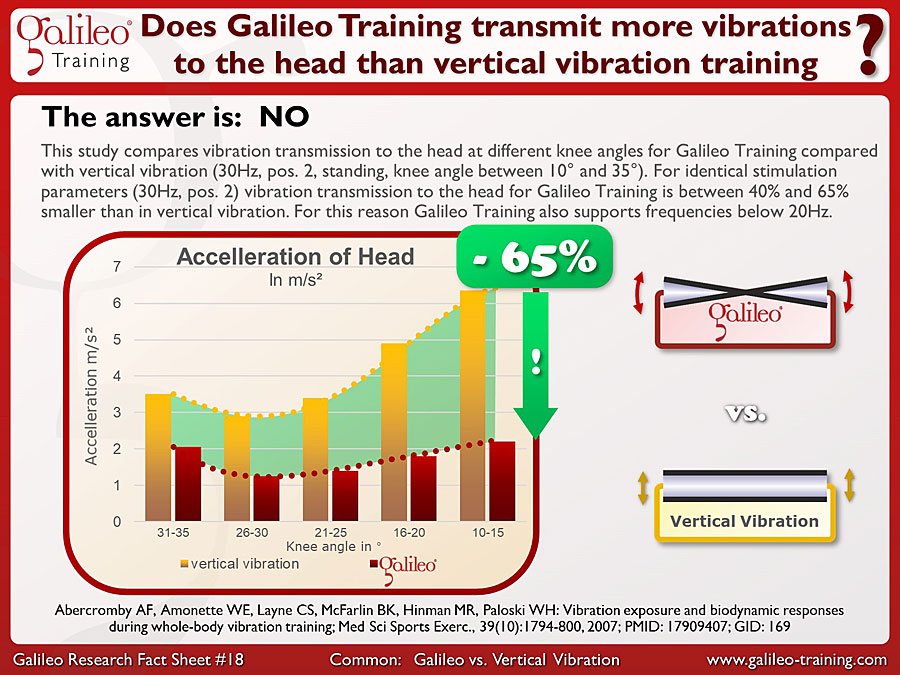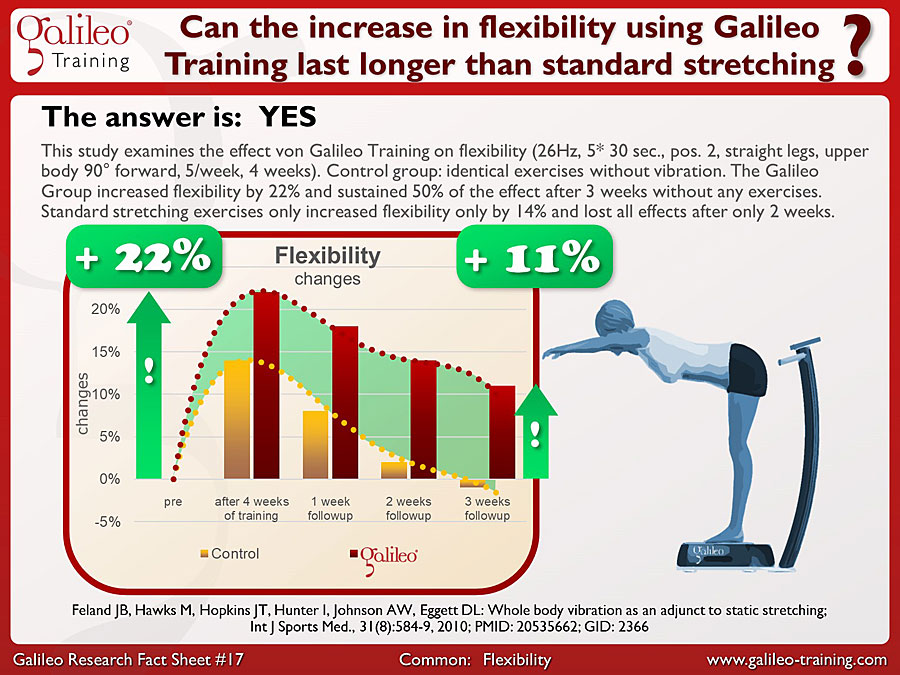This study tested the effect of Galileo Therapy on subjective back-pain (18 Hz, position 3, 7 minutes, 2/week, 12 weeks, hip-tilting in standing). The control group performed lumbar extension exercises, sit-ups and Leg-Press on different exercise-devices. Galileo Therapy reduced the subjective back-pain by 67% (Visual Analog Scale, P-VAS). The control group showed comparable results but needed much more time.
Galileo Info Sheet #1: Galileo Training Galileo Training Frequencies: Which frequency when and why?
Galileo Info Sheet #1: Galileo Training – Frequncy ranges and their apllications - What frequency is needed for which training goal?
Galileo Research Facts No. 23: Is oxygen uptake during Galileo Training independent from frequency and Amplitude?
This study reports the influence of frequency and amplitude during Galileo Training on the oxygen uptake (1 min., 18-34Hz, position 1.5 to 3.5, active standing at 170°). The results show that with increasing frequency and amplitude oxygen consumption during Galileo Training can be increased up to 170%. The effect of higher increasing frequencies dominated the effect of increasing amplitude...
Galileo Research Facts No. 20: Can Galileo Training increase blood flow?
This study reports the immediate effect of Galileo Training on blood flow (26Hz, Pos. 2, 3 minutes, slow squatting, additional weights +35% to +40% of body mass). Control group: Cycling ergometer, 3 min., 50W. In the Galileo Training group blood flow at the foot and calf increase between 120% and 150%. At the same time the cardiovascular reaction is significantly smaller than in cycling ergometer training. ..
Galileo Research Facts No. 24: Is the increase in blood flow highest during active Galileo Training?
This study reports for Galileo Training the influence of frequency and amplitude on blood flow, and the short-term changes over time before, during and after Galileo Training (1 min., 5-30Hz, position 2.5 and 4.5, static squatting). The results show that with increasing frequency and amplitude Galileo Training can increase blood-flow by up to 420% and that it increases by an additional 50% directly after the active training...
Galileo Research Facts No. 19: Can Galileo Training improve short-term leg-press Performance?
This study tested the immediate effect of Galileo Training on one-legged leg-press performance (only 1 leg on Galileo, other leg as control, 10x1 min., 1. min. rest, 26Hz, pos. 4, one-legged on toes, knee angle 100°-110°). Comparison between trained and untrained leg immediately before and after the training. The Galileo Training leg improved velocity and power in the leg-press exercise almost independent of extra loads by almost 10%. ..
Galileo Research Facts No. 18: Does Galileo Training transmit more vibrations to the head than vertical vibration training?
This study compares vibration transmission to the head at different knee angles for Galileo Training compared with vertical vibration (30Hz, pos. 2, standing, knee angle between 10° and 35°). For identical stimulation parameters (30Hz, pos. 2) vibration transmission to the head for Galileo Training is between 40% and 65% smaller than in vertical vibration. For this reason Galileo Training also supports frequencies below 20Hz...
Galileo Research Facts No. 17: Can the increase in flexibility using Galileo Training last longer than standard stretching?
This study examines the effect von Galileo Training on flexibility (26Hz, 5* 30 sec., pos. 2, straight legs, upper body 90° forward, 5/week, 4 weeks). Control group: identical exercises without vibration. The Galileo Group increased flexibility by 22% and sustained 50% of the effect after 3 weeks without any exercises. Standard stretching exercises only increased flexibility only by 14% and lost all effects after only 2 weeks...
Galileo Research Facts No. 16: Can Galileo Training even at high frequencies improve flexibility?
This study tested the short-term effect of Galileo Training on flexibility (26 Hz, 6 minutes, slightly bent knees, 170°). The control group used a cycling ergometer for 6 minutes at moderate 50W). As a result the flexibility measured by sit & reach test improved by 17%, torque in knee extension by 10% and torque in knee flexion by 8%. The control group did not show any significant changes...
Galileo Research Facts No. 15: Can Galileo Training decrease contractures?
This study shows the effect of Galileo Therapy (Cologne Concept: 3x3 minutes, 10 session/week, 26 weeks) with Spina Bifida patients (5-13 years). Contractures in Hip extension improved up to 36% and up to 14% in knee extension. At the same time standing improved by 36% (GMFM-D) and walking improved by 20% (GMFM-E). (Before Galileo Therapy, after Galileo, after additional 6 month without Galileo Therapy)...









